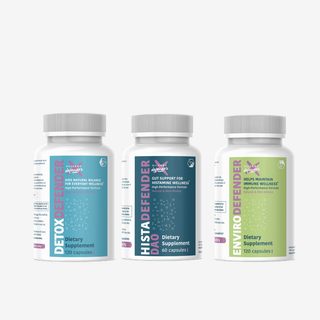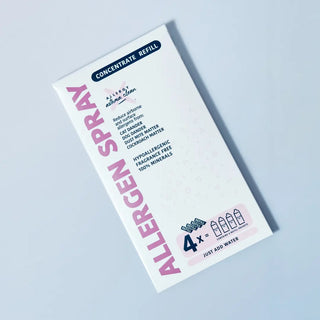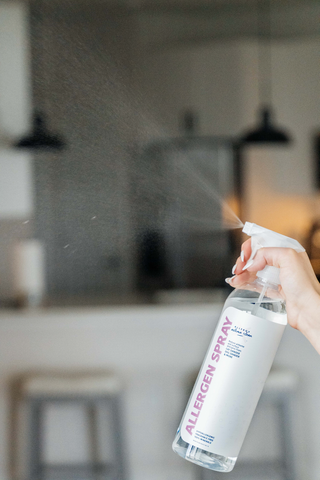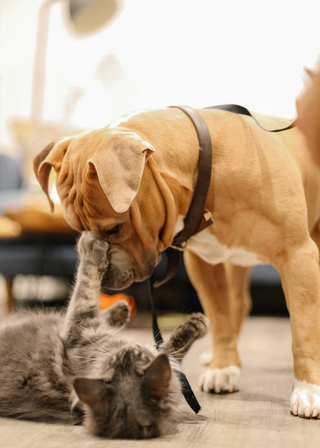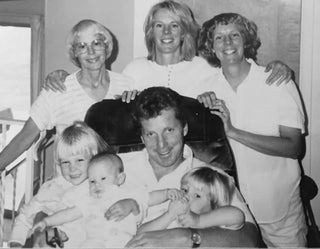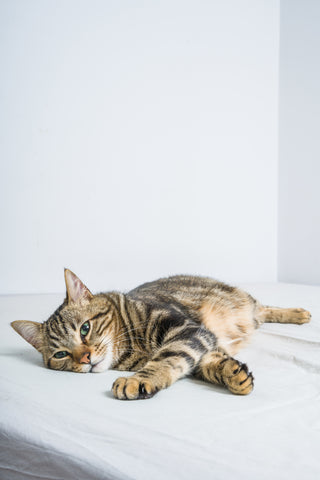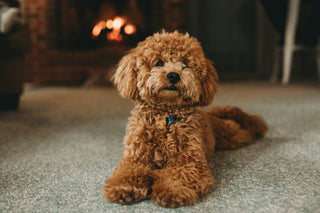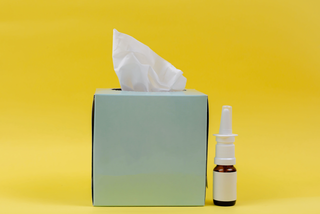TL;DR Cat shedding is natural but manageable. Fel d 1 protein in cat saliva, dander, and skin—not hair—causes allergies. Shedding patterns vary: some cats shed year-round, others seasonally (spring/fall “blowing the coat”). Genetics determine shedding levels (Maine Coons shed heavily; Sphynx cats barely shed). Control strategies: brush frequently (removes 60-80% loose hair before it spreads), feed omega-3-rich diet (promotes healthy coat, reduces excessive shedding), use HEPA vacuum twice weekly, wash bedding in hot water weekly, spray Allergy Asthma Clean Allergen Spray by Allergy Defender to neutralize dander on surfaces and in air, designate cat-free zones (especially bedrooms), bathe cats monthly if tolerated. Low-shedding breeds: Ragdoll, Siberian, Russian Blue. Regular grooming prevents matting and reduces allergen load by 40-60%
Key Takeaways:
- Cat hair is not the allergen – Fel d 1 protein in saliva, urine, dander (dead skin cells), anal glands, sebaceous glands, and skin causes allergies; cat hair only carries allergens
- Shedding influenced by multiple factors – genetics (Maine Coons shed heavily, Sphynx minimal), hormones (heat cycles, pregnancy increase shedding), health (skin conditions, allergies, nutritional deficiencies), environment (temperature changes, stress, anxiety)
- Regular grooming reduces shedding – frequent brushing removes loose hair and prevents hairballs/matting; deshedding tools reach undercoat effectively; occasional baths remove excess hair; professional groomers for thick/long coats
- Diet promotes a healthy coat – omega-3 fatty acids rich foods improve skin/coat condition, reduce excessive shedding; balanced nutrition is essential for coat health
- Seasonal shedding patterns – spring/fall "blowing the coat" phase produces large amounts of hair; indoor cats shed consistently year-round; outdoor cats adjust to temperature changes
- Allergen management strategies – create cat-free zones (bedrooms), wash bedding weekly in hot water with hypoallergenic detergent, vacuum regularly with HEPA filter, use Allergen Spray and air purifiers to reduce exposure
- Low-shedding breed options – Ragdoll, Siberian have minimal shedding requiring less maintenance; research breeds if you prefer less fur accumulation
Are you tired of constantly dealing with cat hair on your clothes, furniture, and even in your food? Understanding cat shedding is the first step to keeping your home fur-free.
Cat hair is not an allergen; it's the cat dander that attaches to the hair that contains allergens.
Regular grooming is essential in controlling cat shedding. Brushing your cat frequently not only helps remove loose hair but also prevents hairballs and matting. Additionally, providing a healthy diet rich in omega-3 fatty acids can promote healthy skin and decrease excessive shedding.
Understanding the Science Behind Cat Shedding
Cat shedding is a natural and necessary process for cats to maintain healthy coats. It helps them get rid of old and damaged hair, making way for new hair growth. Shedding also helps regulate body temperature and remove toxins from the body.
The shedding process is influenced by various factors, including genetics, climate, and overall health. Some cat breeds, such as Siamese or Burmese, might shed less than others, while long-haired breeds like Maine Coons or Persians might shed more.
Cats have a natural shedding cycle that can be influenced by external factors. As the seasons change, cats may go through a shedding phase to adjust to the temperature changes. This is particularly noticeable in outdoor cats. Indoor cats, on the other hand, may shed consistently throughout the year.
Understanding the science behind cat shedding can help you better manage and minimize the amount of hair in your home. By understanding your cat's breed and shedding patterns, you can take proactive steps to control shedding and reduce allergies.
Factors That Influence Shedding in Cats
Several factors influence the shedding process in cats. These include genetics, hormones, health, and environmental factors.
Genetics play a significant role in determining the amount and frequency of shedding in cats. Some breeds are naturally more prone to shedding due to their genetic makeup. For example, Maine Coons have a thick double coat that sheds heavily, while breeds like the Sphynx have very little hair or no hair at all to shed.
Hormones also play a role in cat shedding. Female cats may experience increased shedding during heat cycles or pregnancy. Neutered or spayed cats may have more consistent shedding patterns due to hormonal changes.
The overall health of a cat can also affect shedding. Cats with skin conditions, allergies, or nutritional deficiencies may experience excessive or abnormal shedding. It is important to address any underlying health issues to help manage shedding.
Lastly, environmental factors can influence shedding. Changes in temperature and exposure to sunlight can trigger shedding in some cats. Additionally, stress or anxiety can also lead to increased shedding. Creating a calm and comfortable environment for your cat can help minimize shedding caused by stress.
Common Cat Shedding Patterns
Cat shedding patterns can vary depending on the breed, individual cat, and environmental factors. Understanding the common shedding patterns can help you anticipate and manage shedding effectively.
Some cats have a steady shed throughout the year, while others have more noticeable seasonal shedding. Cats that shed consistently throughout the year may require more frequent grooming and maintenance to control hair accumulation in your home.
Seasonal shedding typically occurs during the spring and fall when cats are transitioning to a new coat. This shedding phase is known as "blowing the coat" and can result in large amounts of hair being shed over a short period of time. Regular brushing during this time can help remove loose hair and prevent it from accumulating in your home.
Certain cat breeds, such as the Ragdoll or the Siberian, have a low-shedding coat that requires less maintenance. These breeds may still shed, but the amount of hair shed is significantly less compared to other breeds. If you prefer a cat with minimal shedding, researching low-shedding breeds can be a good option.
Allergies Related to Cat Shedding
Cat allergies are caused by a protein called Fel d 1, which is found in cat saliva, urine, and dander (dead skin cells). When cats groom themselves, the saliva dries on their fur and becomes airborne, causing allergic reactions in susceptible individuals. Fel d 1 is also found in the anal glands, sebaceous glands and skin. Cat hair is not the source of the allergen.
Symptoms of cat allergies can range from mild to severe and may include sneezing, coughing, itchy and watery eyes, runny nose, and even asthma attacks. It is important to note that cat allergies can develop at any age, even if you were not previously allergic to cats.
If you or someone in your household has cat allergies, managing cat shedding becomes crucial. While it may not be possible to completely eliminate allergens, there are steps you can take to reduce exposure and minimize allergic reactions.
Managing Cat Allergies in Your Home
Managing cat allergies starts with creating a cat-friendly environment that minimizes exposure to allergens. Here are some tips to help you reduce allergens in your home:
- Designate cat-free zones: Create areas in your home where your cat is not allowed, such as bedrooms or on certain furniture. This can help create allergen-free spaces for individuals with allergies.
- Frequently wash bedding: Regularly washing bedding, including blankets and pillowcases, can help remove allergens. Use hot water and hypoallergenic detergent to effectively remove cat dander.
- Vacuum regularly: Invest in a vacuum cleaner with a HEPA filter and use it frequently to remove cat hair and dander from carpets, upholstery, and other surfaces. Vacuuming helps reduce the presence of allergens in your home.
- Consider allergen-reducing products: There are various products on the market designed to reduce cat allergens, such as Allergen Spray and air purifiers.
Tips For Reducing Cat Shedding
While it's impossible to stop a cat from shedding altogether, there are steps you can take to reduce shedding and keep your home fur-free. Here are some tips for managing cat shedding:
- Regular grooming: Brush your cat frequently to remove loose hair and prevent it from ending up on your furniture or clothes. Use a brush or comb suitable for your cat's coat type. Long-haired cats may require more frequent grooming to prevent matting.
- Consider a deshedding tool: Deshedding tools, such as grooming gloves or specialized brushes, can help remove loose hair more effectively. These tools are designed to reach the undercoat and remove excess hair before it ends up on your floors or clothing.
- Provide a healthy diet: A balanced and nutritious diet can promote healthy skin and coat, reducing excessive shedding. It's also good for joint support, brain health, and has anti-inflammatory properties. Look for cat foods that are rich in omega-3 fatty acids, which can improve the overall condition of your cat's coat. Look for foods with these fish as primary ingredients: Salmon (highest omega-3 content), Mackerel, Sardines, Herring, and Tuna.
- Bathe your cat: While cats are generally good at grooming themselves, occasional baths can help remove excess hair, if they allow you to bathe them! Use a cat-friendly shampoo and follow proper bathing techniques to minimize stress for your cat.
- Consider a professional groomer: If grooming your cat at home is challenging or your cat has a particularly thick or long coat, consider taking them to a professional groomer. Groomers have the expertise and tools to manage shedding and keep your cat's coat in top condition.
By following these tips, you can effectively manage shedding and reduce the amount of cat hair in your home.
Cleaning Tips For a Fur-free Home
Keeping your home fur-free requires regular cleaning and maintenance. Here are some cleaning tips to help you achieve a clean and fur-free environment:
- Vacuum regularly: Invest in a vacuum cleaner with a HEPA filter and use it frequently to remove cat hair and dander from carpets, upholstery, and other surfaces. Pay special attention to areas where your cat spends the most time.
- Use lint rollers: Keep lint rollers handy to quickly remove cat hair from clothing, furniture, and other fabric surfaces. Rollers with adhesive sheets are effective in picking up loose hair.
- Use microfiber cloths: Microfiber cloths are excellent for trapping hair and can be used to wipe down surfaces, including furniture and countertops. They are reusable and can be easily washed to remove accumulated hair.
- Wash bedding and fabric surfaces: Regularly wash bedding, blankets, and other fabric surfaces that your cat frequently comes into contact with. Use hot water and hypoallergenic detergent to effectively remove cat hair and dander.
Say goodbye to constant cleaning and hello to quality cuddle time with your cat. By implementing these simple strategies, cat hair will become a minor inconvenience, not a life controller.


